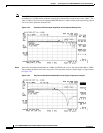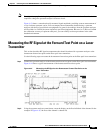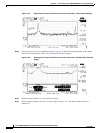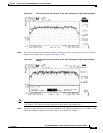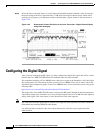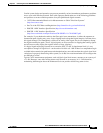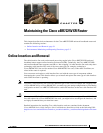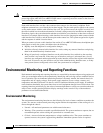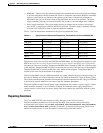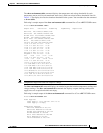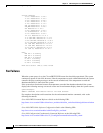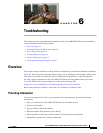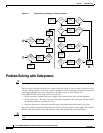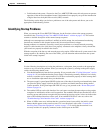
5-2
Cisco uBR7225VXR Universal Broadband Router Hardware Installation Guide
OL-17309-02
Chapter 5 Maintaining the Cisco uBR7225VXR Router
Environmental Monitoring and Reporting Functions
Caution The network processing engine cannot be removed if the router is operating. Removing the network
processing engine while the Cisco uBR7225VXR router is operating causes the router to shut down or
crash, and might damage or destroy memory files.
Each cable interface line card has a bus connector that connects it to the router’s midplane. Each
midplane connector has a set of tiered pins in three lengths. The pins send specific signals to the system
as they make contact with the cable interface line card. The system assesses the signals it receives and
the order in which it receives them to determine if a board is being removed or inserted into the midplane.
From these signals, the system determines whether to reinitialize a new interface or shut down a removed
interface. For example, when inserting a cable interface line card, the longest pins make contact with the
cable interface line card first, and the shortest pins make contact last. The system recognizes the signals
and the sequence in which it receives them.
When you remove or insert a cable interface line card in a Cisco uBR7225VXR router, the midplane pins
send signals to notify the system, which then does the following:
1. Rapidly scans the midplane for configuration changes.
2. Initializes all newly inserted cable interface line cards, noting any removed interfaces and placing
them in the administratively shutdown state.
3. Brings all previously configured interfaces on the cable interface line card back to the state they
were in when it was removed. If the same type of interface card type is reinserted into a slot, its
interfaces are configured and brought online up to the interface count of the original cable interface
line card. If, however, any new interfaces are put in the administratively shutdown state, as if they
were present (but not configured) at boot time, the system must be configured.
Environmental Monitoring and Reporting Functions
Environmental monitoring and reporting functions are controlled by the network processing engine and
allow you to maintain normal system operation by identifying and resolving adverse conditions before
loss of operation. The environmental monitoring functions constantly monitor the internal chassis air
temperature and AC supply voltages. Each power supply monitors its own voltage, currents, and
temperature and shuts itself down if it detects a critical condition within the power supply. If conditions
reach shutdown thresholds, the system shuts down to avoid equipment damage from excessive heat. The
reporting functions periodically log the values of measured parameters so that you can retrieve them for
analysis later, and the reporting functions display warnings on the console if any of the monitored
parameters exceed defined thresholds.
Environmental Monitoring
The environmental monitoring functions use the following five levels of status conditions to monitor the
system. Two sensors on the network processing engine monitor the temperature of the cooling air as it
moves through the chassis.
• Normal—All monitored parameters are within normal tolerances.
• Warning—The system has exceeded a specified threshold. The system continues to operate, but we
recommend operator action to bring the system back to a normal state.
• Critical—An out-of-tolerance temperature or voltage condition exists. The system continues to
operate; however, the system is approaching shutdown. Immediate operator action is required.



